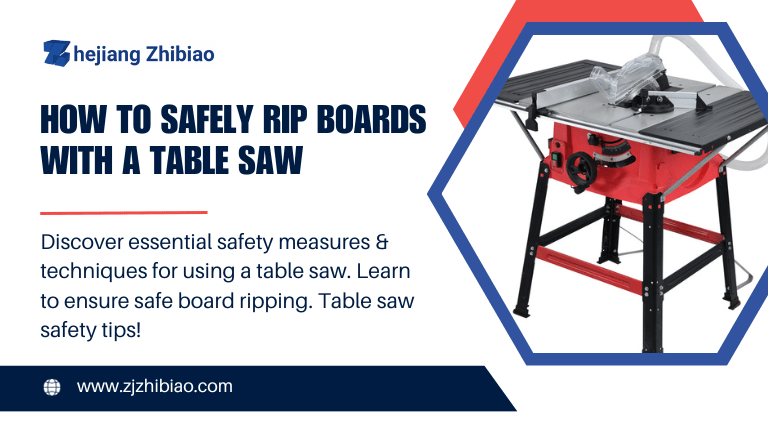Woodworking is a rewarding hobby that allows individuals to showcase their creativity and craftsmanship. However, it is crucial to prioritize safety when using power tools, especially the table saw. In this blog post, we will explore the importance of table saw safety and provide a step-by-step guide on how to safely rip boards with a table saw. So, let’s dive in and learn how to make the most of this powerful tool while keeping ourselves safe.
In the world of woodworking, the table saw stands as a pinnacle tool, a true workhorse in the craft. Its power and precision make it a go-to for woodworkers and DIY enthusiasts alike. However, it’s crucial to recognize that beneath its utility lies a potential for danger. Every year, numerous accidents occur due to mishandling or lack of adherence to safety precautions. This article serves as a comprehensive guide, emphasizing the importance of table saw safety and equipping you with the knowledge and techniques needed to use this powerful tool safely.
Read More: A Comprehensive Overview Of Table Saw Types And Features
Table of Contents
ToggleUnderstanding Table Saw Safety:
Before we delve into the specifics of ripping boards, it is essential to understand the importance of prioritizing safety in woodworking. A table saw is a powerful tool that can cause serious injuries if not used correctly. By familiarizing ourselves with the basic components of a table saw, we can ensure safe usage.
The main components of a table saw include the blade, the fence, the miter gauge, the arbor, and the power switch. The blade is responsible for cutting the wood, while the fence helps guide the wood along a straight path. The miter gauge is used for making angled cuts, and the arbor holds the blade securely in place. Understanding the functions of these components will enable us to make necessary adjustments for safe and accurate cuts.
Preparing for Safe Board Ripping:
To ensure a safe woodworking experience, it is crucial to gather the necessary safety equipment before operating a table saw. Eye protection, such as safety glasses or goggles, shield our eyes from flying debris. Ear protection, such as earplugs or earmuffs, helps reduce the noise generated by the table saw. Additionally, a dust mask protects our lungs from inhaling sawdust.
Furthermore, push sticks or blocks should be used to maintain control and keep our hands at a safe distance from the blade. These tools allow us to exert force on the material without putting our hands in harm’s way. Lastly, before starting any woodworking project on the table saw, it is important to clear the workspace of clutter and distractions, creating a safe environment.
Adjusting the Table Saw for Accurate Cuts:
Properly adjusting the table saw is crucial for achieving accurate and safe cuts. Before starting, it is essential to check the blade alignment. First, adjust the blade height so that it protrudes only slightly above the material being cut. This minimizes the risk of kickback and provides a clean cut. Additionally, ensure that the blade is parallel to the fence guides to prevent the wood from binding and causing dangerous kickback.
Once the blade is aligned, adjust the fence for the desired board width. The fence should be parallel to the blade and securely locked in place. This will ensure that the wood is guided accurately and prevent any unnecessary accidents.
Safe Techniques for Ripping Boards:
Now that we’ve prepared our table saw and gathered the necessary safety equipment, let’s focus on the safe techniques for ripping boards. Proper body and hand positioning play a crucial role in maintaining control and avoiding accidents.
When operating a table saw, it is important to maintain a comfortable stance. Stand with your feet shoulder-width apart, slightly bent at the knees, and keep your weight evenly distributed. This stable posture will provide better control and stability throughout the cutting process.
Hand placement is equally important. Keep your hands at a safe distance from the blade, and never position them directly behind the blade. Instead, place your hands on either side of the material, providing stability and control without compromising safety.
Following safe feeding techniques is also essential. Before starting the cut, establish a firm grip on the material you are about to rip. This will prevent the wood from slipping or being pulled into the blade. As you feed the material through the blade, apply consistent pressure, but avoid excessive force. Let the table saw do the work, and maintain control throughout the cut.
Common Safety Mistakes to Avoid:
To ensure a safe woodworking experience, it is crucial to be aware of and avoid common safety mistakes, particularly those related to kickback situations. Kickback occurs when the wood binds against the blade, causing it to be forcefully thrown back towards the operator. To minimize the risk of kickback, never stand directly behind the blade. Instead, position yourself to the side, ensuring a clear path for the wood to follow.
Inattentiveness and Distractions
One of the most prevalent mistakes leading to table saw accidents is inattentiveness. Whether it’s a distraction caused by a passing thought, a sudden noise, or a lack of focus due to fatigue, not being fully present while operating a table saw can lead to serious injuries. Staying focused and fully concentrated on the task at hand is imperative.
Neglecting Maintenance of the Table Saw
Regular maintenance of a table saw is not just a suggestion but a crucial safety practice. Neglecting to routinely inspect and maintain the saw can lead to various hazards, including malfunctions, inaccurate cuts, and potentially dangerous situations. Ensuring that the saw is in optimal working condition is essential for safe operation.
Disregarding Safety Features and Gear
The safety features and equipment provided with a table saw are there for a reason – to protect the user. Disregarding safety guards, riving knives, push sticks, or not using appropriate safety gear like goggles or ear protection significantly increases the risk of injury. Always utilize the safety features and gear provided for your protection.
Incorrect Tool Usage
Improperly using a table saw can lead to serious accidents. This includes forcing the material through the blade, using the wrong blade for the task, or not adjusting the tool properly for the cut. Understanding and following the recommended operating procedures is key to a safe working environment.
Overconfidence and Rushing
Overconfidence can be a silent enemy in woodworking. Rushing through cuts or feeling overly confident in one’s abilities can lead to mistakes and accidents. Taking time to set up cuts properly, following safety procedures, and maintaining a patient approach significantly reduces the likelihood of accidents.
Understanding these common mistakes and actively avoiding them is pivotal in ensuring your safety while working with a table saw. If you have any further queries regarding safe table saw operation, feel free to ask!
Additional Tips for Table Saw Safety:
Safety Guidelines for Specific Materials
Different materials present varied challenges when using a table saw. For instance, cutting hardwoods versus softwoods might require adjustments in cutting speed, blade type, or even the feed rate. Understanding these material-specific nuances can significantly enhance safety and precision.
Importance of Regular Inspections and Maintenance
Regular inspections and maintenance are not mere suggestions but critical aspects of table saw safety. Ensuring the blade is sharp, the safety features are intact, and the entire tool is in optimal working condition can prevent unexpected malfunctions and potential hazards. Routinely checking the alignment, power switch, and the condition of safety guards can go a long way in maintaining a safe workspace.
Ensuring Ample Workspace and Clear Pathways
A cluttered and confined workspace can lead to accidents. Always ensure there is enough space around the saw for free movement and the passage of material. Clearing the paths and removing potential obstructions can prevent tripping hazards and provide a clear line of sight, improving overall safety.
Understanding Emergency Procedures
Despite all precautions, emergencies can happen. Being well-versed in emergency shut-off procedures, having a first aid kit on hand, and knowing basic first aid techniques can mitigate the severity of an accident, should one occur. Preparedness is key in ensuring safety at all times.
Using Outfeed Support for Large Materials
Large materials can be unwieldy and pose a risk during cutting. Employing outfeed support, such as a table extension or roller stands, can provide stability and prevent materials from tipping or binding during cutting, ensuring a smoother and safer operation.
Feel free to let me know if you need further details or have any specific questions about table saw safety!
Conclusion:
Woodworking can be a fulfilling and enjoyable experience when done safely. By following the steps outlined in this guide, you can confidently rip boards with a table saw while prioritizing your safety. Remember to gather the necessary safety equipment, adjust the table saw for accurate cuts, and utilize safe techniques for ripping boards. Avoid common safety mistakes, maintain a clean work area, and conduct regular maintenance checks on your table saw.
Always prioritize your safety and the safety of those around you. By taking the necessary precautions, you can enjoy your woodworking projects while minimizing the risk of accidents. Happy woodworking!
Remember, if you ever need additional guidance, there are numerous online resources, forums, and communities dedicated to woodworking safety and techniques. Stay safe, and happy woodworking!






